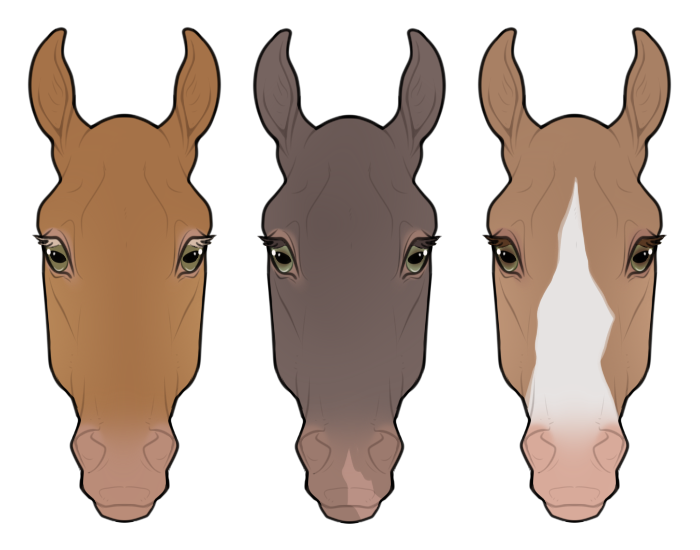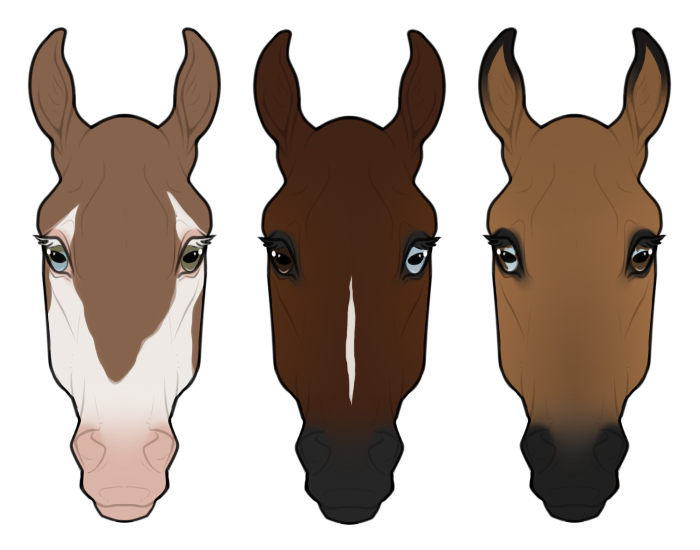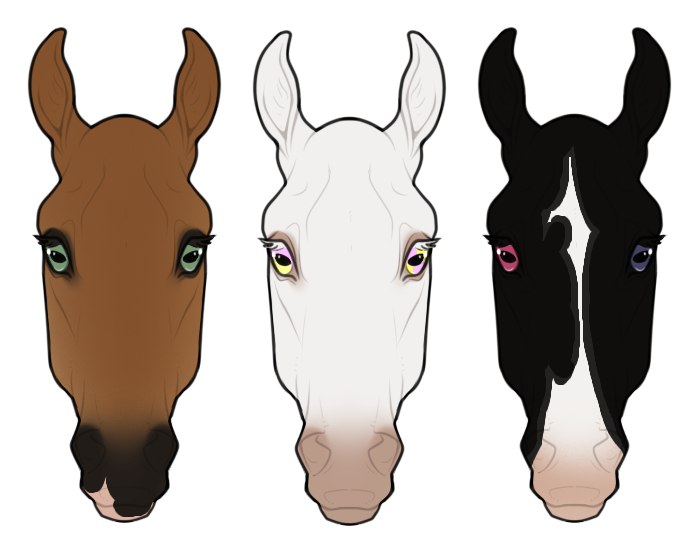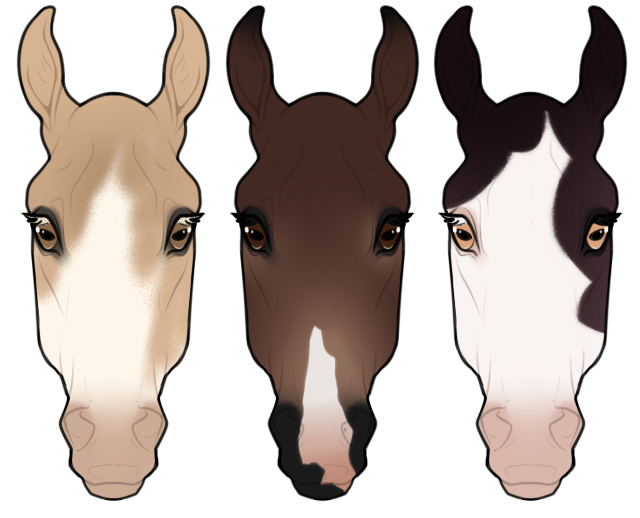The miniguides below are designed to help you through some of the more minor details of your design!
Natural Eye Colors Breed-Specific Eye Colors Eyelashes Hooves/Chestnuts
NATURAL EYE COLORS
Brown

Single Cream, Walnut, and undiluted base colors have brown eyes.
Brown eyes are the most common, and come in a range of shades. They can be dark or light, but shouldn't quite cross into being tan/gold nor near-black.
BLUE

Double Cream and some specific markings cause blue eyes.
Natural blue eyes should be fairly light. They do not tend to be especially saturated, and can sometimes even appear greyish. They should not be dark/deep blue, and shouldn't lean too far toward green or indigo/purple.
GREEN/HAZEL

Champagne and Pearl cause green/hazel eyes.
Green and hazel eyes are very similar. They should be a muddy greenish shade that generally leans more toward yellow than blue. Hazel eyes have brown around the pupil, and are sometimes more green-blue around the edges. Green eyes should be fairly light and warm. Sometimes they have tan/amber tones as well. They should not be dark/saturated shades like emerald or forest green.
HETEROCHROMIA

Heterochromia is not an eye color itself, but rather an optional expression for blue-eyed white patterns.
It can only be present if the horse has a white pattern that causes the eyes to be blue. In this case, they will be blue + whatever color is below based on the Hierarchy. For example, a horse with Overo and Orchid can have blue & pink, while a horse with Splash and a Bay base coat can have blue & brown. The blue may fully color one eye and/or have a patch in one or both.
BREED-SPECIFIC EYE COLORS
ORCHID

Orchid causes pink eyes.
Similarly to their skin tone, Orchid horses' eyes should not be particularly saturated. They should be a warm, slightly desaturated shade, not hot pink or dark pink. They should lean more toward orange than purple in hue.
FRAICHE

Fraiche causes gold/yellow, yellow-green, or blue eyes.
The first two are inspired by cat eye colors, and should be fairly bright. They still shouldn't be hyper-saturated/neon, but they are not as muted as natural colors. Blue Fraiche eyes should be light and not too saturated, similar to natural blues described above.
BERRY

Berry causes medium/light blue or purple eyes.
Blue eyes here may fall into a darker range than typical blues. This medium-blue shade is not particularly dark, but is still notably darker than natural blues. They can, however, have light blues as well! The purple shade for Berry is fairly light and desaturated, and should be closer to blue than to red/pink.
PLUM

Plum causes gold-yellow, purple, pink, or brown eyes.
Gold-yellow Plum eyes fall into a similar range as Fraiche gold-yellows. Purple eyes range from lavender to magenta hues, but in all cases they should be mostly desaturated. Pinks should be warm and desaturated. Brown eyes here are, of course, subject to normal brown eye rules.
CAPENSIS

Capensis causes orange, peachy-orange, or gold eyes.
All colors should be fairly saturated, but not neon. Orange shades should not be too dark or too light, just medium shades, and can have a slight peachy tone. They should not become pink, nor should gold shades become yellow.
HOODED

Hooded causes optional dark brown eyes, regardles of base color.
They should still be noticeably brown, not black or grey. Should be dark instead of medium or light brown like natural brown eyes. This effect is optional on Hooded horses and can be disregarded if desired.
RIFT

Rift causes blindness in all horses with the oddity, represented by a pale/low-opacity pupil. All Rift horses will have very pale blue eyes unless they also have Gemstone, in which case they may be a different hue (but still pale/blind).
Third example shows Gemstone + Rift interaction, with Gemstone causing the eyes to be pale green.
GEMSTONE

The Gemstone oddity causes the eyes to be any color except greyscale. They must have a noticeable hue, and cannot contain more than two colors total. Bicolored gemstone presents like Heterochromia but doesn't have to be blue; first color goes on as normal, then a second color may fully color an eye and/or cause patches in one or both.
EYELASHES
-
Must be white if covered by a white marking
-
If not covered by a marking, they should be one of the following:
-
Matching the primary mane/tail color (excl. white markings)
-
Dark (grey/near-black) if coat color is medium or dark (black, chestnut, berry, etc)
-
Light (white/light cream) if coat color is light (cremello, shoal, palomino, etc)
-

Silver gene may cause light lashes even on an otherwise dark base coat

Light vs Dark vs affected by white markings
HOOVES/CHESTNUTS

-
If covered by white markings, hooves must be tan/shell colored (or split if partially covered).
-
Tan/shell colored hooves should not be overly pink nor super desaturated
-
Must be clearly visible as well - don't make them too light!
-
-
If not covered by white markings, hooves should be dark/grey-brown.
-
Value varies by coat shade - darker coats will have darker grey hooves, and vice versa
-
May have a very slight brown tint, but should read "grey" and not "brown" overall
-
The "chestnuts" are the small oval-shaped bits on the inside of the horse's legs - they follow the same rules as listed above for the hooves!